Thomas Bertram and Lizzie M-P
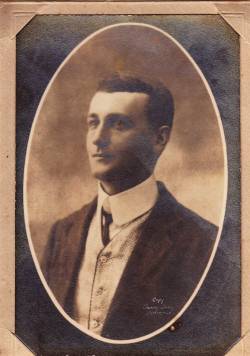 Thomas B. M-P taken by professional photographer in Brisbane.1)
Thomas B. M-P taken by professional photographer in Brisbane.1)
Thomas Bertram (4 February 1883 - 25 August 1946) was Thomas de Montmorenci and Florence M-P's third child and only son. He was the 5th consecutive Thomas Murray-Prior. His mother unsuccessfully tried to subvert the tradition of calling the first-born son Thomas - she called him Bertie, though the rest of the family stuck with Tom. TLM-P and his aunt Rosa Praed were godparents.2) There is confusion over his place of birth. TLM-P wrote that Thomas Bertram was born at Moonbago Station, South Kennedy, Bully Creek, a station owned by TLM-P.3). Matthew Fox 4) states he was 'born on “Bulliwallah” Station, Northern Queensland'. Thomas Bertram's death certificate, which did not have a family member as an informant, assumed he was born at Maroon. It is most likely that TLM-P was correct, and that he was born at Moonbago Station.
Matthew Fox 5) claims that Thomas Bertram was educated at Armidale, NSW, until he was 18 years old. If so, the school he attended was almost certainly The Armidale School (TAS). Thomas Bertram then returned to Maroon Station, and a year later his father died. Thomas B. M-P was 'one of the trustees of the estate', and 'became manager until (most of) the property, which originally comprised 10,000 acres, was sold for purposes of closer settlement.' Thomas B. M-P kept the old homestead, with 600 acres of land, 'with its picturesquely wooded hills and well-grassed pasture lands.' He mainly used the remaining land to breed 'shorthorn cattle from stock originally introduced by his late father' and stock imported from New Zealand, 'the progeny from which have been frequent prizewinners at Brisbane shows.' In the early 1920s, when Fox was writing the entry, Thomas Bertram had a stud consisting of 'about 50 cows of the finest shorthorn type'. In addition, he was planning to introduce mixed farming to Maroon. The success of Thomas Bertram's stud is indicated by the sale of two bulls in 1914 for, respectively, 32 and 110 guineas (in 2022 values, the latter is around $22,185).6)
Fox also states that Thomas Bertram was a Justice of the Peace and during 1914-17 was an elected member of the Goolman Shire Council7) and on the committee of the Boonah Agricultural Society.8) While his father donated the land for the first Maroon School which opened in 1891, mainly for the children of settlers taking advantage of the closer settlement acts, it was Thomas B. M-P who chaired the first committee to establish the school.9)
One account suggests that Thomas B. M-P was sympathetic towards the indigenous owners of the land. What became known as the last great corroboree of the local tribes was held at Maroon in 1905. As Thomas B. M-P owned Maroon then, the Aboriginal participants would have had his permission to congregate. The recollection is second hand (a man recounting his then 11-year old mother's memory 68 years later), but states that the local settlers were part of the audience and contributed food. The corroboree featured a huge bonfire and traditional dances 'The Hunt' and the 'Dying Kangaroo“.10)
For photographs of the family at Maroon that, from the women's clothes, appear to be in the 1910s, click on Maroon.
 Card featuring St Andrew's Church, Maroon - the M-Ps, presumably Thomas B. M-P, were responsible for its erection in 1907.11)
Card featuring St Andrew's Church, Maroon - the M-Ps, presumably Thomas B. M-P, were responsible for its erection in 1907.11)
On 18 February 1911, Thomas B. M-P married his cousin, Elizabeth Katherine (Lizzie Kate) Lightoller (29 October 1887—21 January 1949).12) her name causes confusion: she was registered as Lizzie Kate but the name she gave in her husband's death notice was Elizabeth Katerine. She was commonly known not only as 'Dickie' but also 'Elsie' - the latter name was used in her marriage and death notices in the newspaper.13) She was the daughter of well-known Brisbane physician, Dr Henry Lightoller. Dr Lightoller's grandmother was Rosa Haly (nee Harpur), Matilda M-P's sister.14)
Thomas B. and Lizzie M-P had four children - information about them is available to family members.
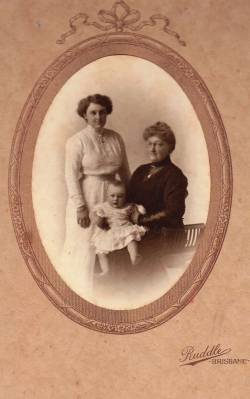 'Dickie' M-P, her mother Maria Theresa (Minnie) Lightoller (nee Haly), and Dickie and Thomas B's eldest son. For more photos of the Lightollers, click on **Lightoller**
'Dickie' M-P, her mother Maria Theresa (Minnie) Lightoller (nee Haly), and Dickie and Thomas B's eldest son. For more photos of the Lightollers, click on **Lightoller**
The Lightollers, Dr Henry and Minnie Lightoller, were family friends as well as relatives, though Nora M-P strongly disapproved of Dr Lightoller's attitude to pain relief in childbirth. He refused his wife Minnie chloroform until he needed to use instruments to birth the baby. Nora, as she wrote to Rosa Praed, considered 'Dr Lightoller is a staunch opponent of Chloroform tho' his chief argument against it seems to be the cowardice of taking it which I think is a question for the sufferer to decide, and could not help telling him what I felt keenly, that were it a misfortune to which both sexes were liable chloroform would have been given long ago. He looked astounded at my venturing to discuss the subject, looking on it as becoming in a man and a doctor to lay down the law – for women ‘theirs is not to reason why – theirs but to suffer and die - a view of the case against which I, as one of the suffering class. protest vehemently. He is a good little dogmatic man, skilful in his degree and he has the best wife that ever trod shoe leather - but I wish she would not be so submissive as regards chloroform.’ Nora went on to say that Minnie told her 'that she had been 12 hours in the most fearful agony, at the end of which they had given her chloroform which had brought it on so they could use instruments'. Nora's view was that she 'would want to know a very good reason why before I would suffer like that in deference to my husband's general principle and it stands to reason that she would recover better if she were not so long ill and in pain'. She was indignant that Dr Lightoller had made Minnie promise not to expect chloroform unless it was necessary for him to use instruments.15) The reasons for Dr Lightoller's reluctance to use chloroform may have been due to common religious view that women were ordained since Eve to give birth in pain, and/or due to concern for its safety. It was also in keeping with the general reluctance of Brisbane Hospital doctors to use anaesthetics even for amputations and other major surgery even years after its use was routine elsewhere.16)
It was probably Lizzie M-P who was one of the three trustees for the Maroon School of Arts after it was built in 1903-04: the Maroon booklet says “Mrs T.A. Murray-Prior', presumably a misprint for Mrs T.B M-P as Thomas B. M-P was one of the Presidents of the School of Arts. The
In the early twentieth century, the local settlers also played tennis on the court at Maroon homestead.17) In later decades, the area would look back with nostalgia at the happy social days at Maroon: 'During the regime of the Murray-Priors, dances, picnics and riding parties were the order of the day. many of the young people of Brisbane making the long journey by train and biggy to join in these festivities',18)
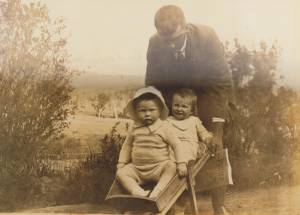 This photo is dated c.1914-15, and is of Thomas B. (still clutching his copy of the Pastoral Review) at Maroon with his eldest son and the latter's cousin, Minnie Palmer.19)
This photo is dated c.1914-15, and is of Thomas B. (still clutching his copy of the Pastoral Review) at Maroon with his eldest son and the latter's cousin, Minnie Palmer.19)
For more family photos of Thomas B. and Lizzie Kate M-P click on Thomas B. & Lizzie.
By Thomas B. M-P's time, the district around Maroon was no longer isolated. In 1914, the property was subdivided with Thomas B. M-P retaining the portion with the homestead on it. The auction on 20 April 1914 brought in around £27,000 with an average price of just over £3 per acre. Thomas B M-P privately purchased the homestead lot of 608 acres at £7/2/4/ an acre; while two adjoining lots were respectively purchased by his sister Ethel (Mrs W.B. Butler - 205 acres at £3/5/0) and 'Miss Murray-Prior' (another of his sisters? 172 acres at £4/7/6).20)
In November 1920, Thomas B. M-P sold his remaining section of Maroon.21) There are numerous family stories about why, though nothing certain. A probable factor was his sight: he was badly injured when mustering cattle on the station in 1914, with the result that one of his eyes had to be removed.22) Another factor is that, by the end of World War I in 1918, the area was grief-stricken and deprived of many of its young men who provided the local labour. Maroon had the sad distinction of having the highest casualty rate of any community in Australia during that War: from a small number of families, 42 men enlisted, including 8 sets of brothers. Of these 42 men, 17 (40%) died. Unless Maroon men were exceptional, the rest returned nursing psychological and physical wounds.23)
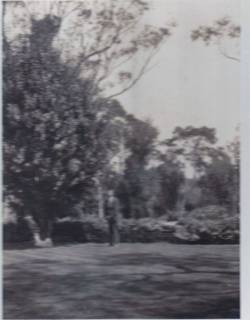
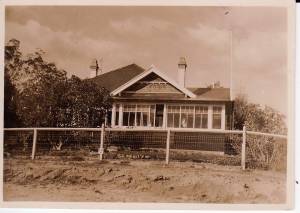
 Three views of Birrilli, home of Thomas B. and Lizzie M-P. The first indistinct photo is of Thomas B. M-P in the garden.24)
Three views of Birrilli, home of Thomas B. and Lizzie M-P. The first indistinct photo is of Thomas B. M-P in the garden.24)
After selling Maroon, Thomas B., Lizzie and their children moved to Southport.25) Around 1924, they moved again, to 'Birrilli', Kensett Avenue, Leura in the Blue Mountains west of Sydney. It was thought that the climate would be healthier for their youngest son Hugh who had contracted polio. In 1937 Thomas B. was elected to the Leura Urban Committee.26)
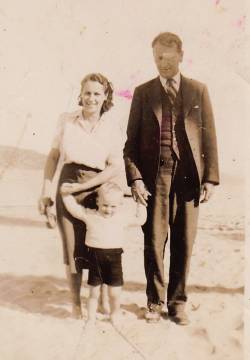 Three generations of M-Ps: Thomas B. M-P, his daughter-in-law and her eldest son. Thomas B. is dressed in conventional business attire of the 1940s: it made few concessions to the Australian climate!
Three generations of M-Ps: Thomas B. M-P, his daughter-in-law and her eldest son. Thomas B. is dressed in conventional business attire of the 1940s: it made few concessions to the Australian climate!
Thomas B. and Lizzie separated around the end of the war or shortly after, with Thomas B. reputedly leaving with the nurse hired to look after polio-affected young Hugh. Thomas B. did not enjoy his new relationship for long. His death certificate revealed that he had had high blood pressure for around 20 years and, for his final year of life, the related and painful kidney condition of malignant nephrosclerosis. Thomas B. died on 25 August 1946.27) His last address was Irish Harp Road (now Regency Road), Prospect, Adelaide, South Australia. Probate - along with the family money - was granted to Stella Gilmore Prior.28) It is believed that Stella later returned to her homeland New Zealand, possibly with her and Thomas's child, though no such child was noted on his death certificate.
A search of the New Zealand papers reveals a mystery. There are reports of visits to that country by Thomas B. and his wife on several occasions before and during World War I.29) Even odder are the reports that Thomas B. M-P stayed there, apparently for over a year, in 1935-36,30) then left for Vancouver.31) Was this another Thomas B. M-P, a misprint, or unexplained activity in New Zealand?